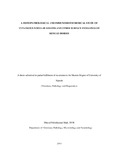A histopathological and immunohistochemical study of cutaneous nodular lesions and other surface swellings of Kenyan horses
Abstract
The objective of the study was to determine the trends of nodular cutaneous lesions and other
surface swellings of the horse in Kenya and to relate the histological and
immunohistochemical characteristics to the clinical parameters.
The study used the retrospective and prospective cases presented to the Department of
Veterinary Pathology, Microbiology and Parasitology, University of Nairobi for histological
diagnosis and from which a diagnosis of cutaneous pathology was recorded. The procedure
involved retrieval of diagnostic reports from retrospective cases and histopathological
examination of both retrospective and prospective cases. Each case was evaluated for the
type and frequency of histological lesions and clinical data. Parameters included analyses of
age, sex, breed, geographical origin, diagnosis, location of neoplasms, the pathology of the
lesion, and the clinical features presented. The histological features were compared between
cases and cellular behaviour was correlated with clinical parameters. Immunohistochemistry
was performed on morphologically related lesions.
A total of 141 cases were identified for the study at the Department, between 1967 and 2014.
Neoplastic lesions accounted for 64.5% (91/141) while inflammatory lesions accounted for
31.9% (45/141). The most common neoplastic lesion was squamous cell carcinoma (35.2% -
32/91), followed by the equine sarcoid (20.9% - 19/91), melanocytic neoplasms (18.7% -
17/91) and fibroblastic neoplasms (14.3% - 13/91). The most common inflammatory lesion
was granuloma (46.7% - 21/45), most of which were granulomas exhibiting the presence of
numerous eosinophils, due to a likely parasitic aetiology. There were two cystic cases, an
epidermoid cyst and a dermoid cyst. Two different biopsies submitted from a 3 year old male
were associated with cutaneous lesions caused by Besnoitia spp. Other granulomas exhibited
histological characteristics similar to those of a fibroblastic neoplasm. A few cases of “proud
flesh” were also encountered.
Immunohistochemistry was performed according to the manufacturer’s (Dako®) protocol and
it resulted in adequate staining of the antigen on selected cases. The histological diagnosis
was confirmed in most instances (90% - 18/20). Discrepancies were encountered between the
histopathological diagnosis and the results of immunohistochemistry in 10% (2/20) of the
cases.
This study is the first to document the cutaneous lesions and other surface swellings of horses
in Kenya, describing the histological and immunohistochemical characteristics. The study has
also established that commercially available standardized immunohistochemical kits for
various antigens can be used effortlessly to help distinguish between various morphologically
related lesions. The results form the basis for further studies on the application of
immunohistochemistry in routine veterinary diagnostics in Kenya.
Key words: Equine, Horse, Cutaneous, Neoplastic, Non-neoplastic, Equine sarcoid,
Squamous cell carcinoma, Granuloma, Besnoitia spp., Histopathology,
Immunohistochemistry

